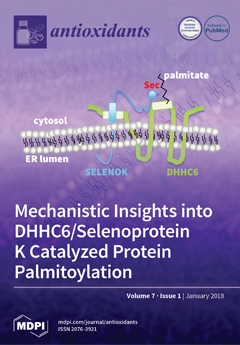Lung cancer, together with head and neck cancer, accounts for more than one-fourth of cancer deaths worldwide. New, non-toxic therapeutic approaches are needed. High-dose IV vitamin C (aka, pharmacological ascorbate; P-AscH
−) represents a promising adjuvant to radiochemotherapy that exerts its anti-cancer
[...] Read more.
Lung cancer, together with head and neck cancer, accounts for more than one-fourth of cancer deaths worldwide. New, non-toxic therapeutic approaches are needed. High-dose IV vitamin C (aka, pharmacological ascorbate; P-AscH
−) represents a promising adjuvant to radiochemotherapy that exerts its anti-cancer effects via metal-catalyzed oxidation to form H
2O
2. Mn(III)-porphyrins possessing superoxide dismutase (SOD) mimetic activity have been shown to increase the rate of oxidation of AscH
−, enhancing the anti-tumor effects of AscH
− in several cancer types. The current study demonstrates that the Mn(II)-containing pentaazamacrocyclic selective SOD mimetic GC4419 may serve as an AscH
−/O
2•− oxidoreductase as evidenced by the increased rate of oxygen consumption, steady-state concentrations of ascorbate radical, and H
2O
2 production in complete cell culture media. GC4419, but not CuZnSOD, was shown to significantly enhance the toxicity of AscH
− in H1299, SCC25, SQ20B, and Cal27 cancer cell lines. This enhanced cancer cell killing was dependent upon the catalytic activity of the SOD mimetic and the generation of H
2O
2, as determined using conditional overexpression of catalase in H1299T cells. GC4419 combined with AscH
− was also capable of enhancing radiation-induced cancer cell killing. Currently, AscH
− and GC4419 are each being tested separately in clinical trials in combination with radiation therapy. Data presented here support the hypothesis that the combination of GC4419 and AscH
− may provide an effective means by which to further enhance radiation therapy responses.
Full article






